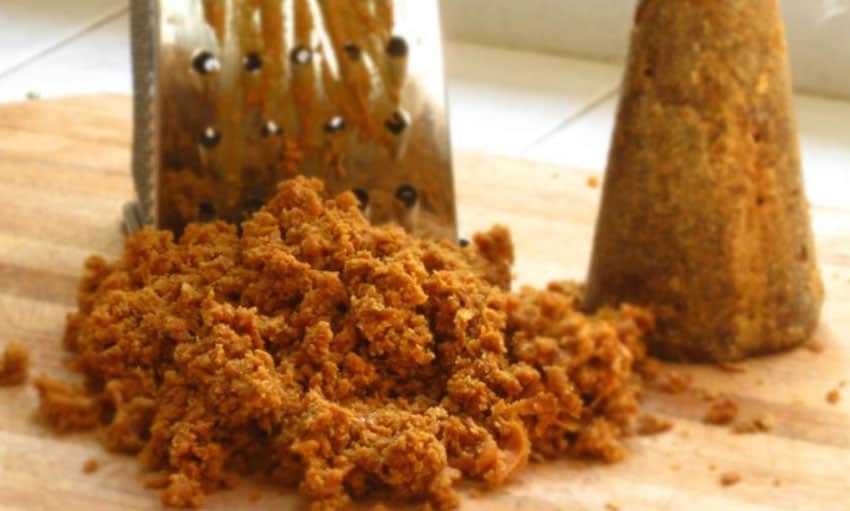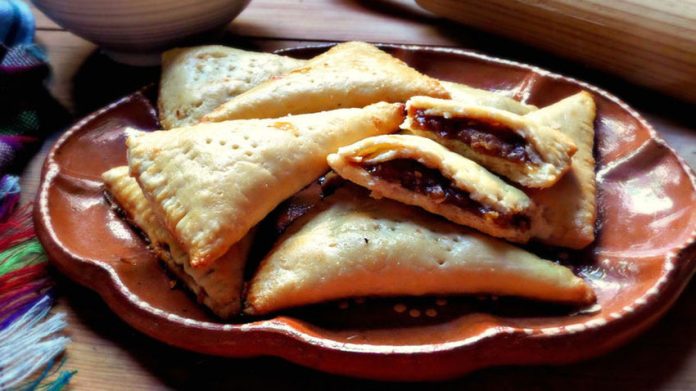As someone who likes to bake, I was surprised not to find brown sugar as I knew it in any stores when I first moved to Mexico. I actually remember bringing it from the States and hoarding it; in fact, I know of a friendship that was broken over a bag of brown sugar promised and then given to someone else.
Eventually I realized that piloncillo – those cones of what looked like brown sugar in every market and grocery store – is similar enough to use as a substitute. True, it takes some effort to grate them, but the flavor is well worth the effort.
A bigger issue perhaps was how to pronounce “piloncillo” (pea-loh-n-SEE-yo). It’s actually quite a pretty word, and here is exactly what it should sound like: https://www.youtube.com/watch?v=lf6SK3i0JhM
So what exactly is piloncillo? Some people think it’s like a solid form of molasses, but that’s incorrect. Piloncillo is its own product; molasses is a by-product of refining sugar, and thus has a much more bitter taste.
What we know as “brown sugar” is just refined white sugar with molasses added. Piloncillo has a richer, earthy flavor and an abundance of B-vitamins and minerals not found in other refined sugars.

In the simplest terms, piloncillo is evaporated sugar cane juice. The sugar canes are crushed, releasing a clear, greenish liquid – sugar cane juice, which is actually quite delicious to drink, chilled, on its own. That liquid is boiled and boiled, and as it evaporates what’s left gets darker and sweeter as it concentrates.
Finally the thickened syrup is poured into molds, most commonly small cones or blocks, and cooled. Voila! Piloncillo. Other countries have similar products: In India, it’s called jaggery or gur; in most other Latin and South American countries it’s known as panela (confusing in Mexico because that’s a kind of cheese) and in Brazil it’s called rapadura.
It’s OK to store the little cones in a glass jar or plastic bag or container in a cupboard, but I prefer keeping them in the fridge just because, well, it’s sugar, y’know? It’s not a bad idea to have a little jar of it already grated on hand for easy use.
Depending on the recipe, there are different ways to use piloncillo. It dissolves surprisingly quickly in hot water, if that works for your recipe. This can also be done in a microwave, as long as the bowl is big enough for it to bubble up a lot. Otherwise, you’ll need to grate it with a hand-held cheese grater.
Piloncillo Empanadas
Best eaten warm right out of the oven, these empanadas can also be reheated in a conventional or toaster oven. Use a prepared pie crust or your own recipe to make the dough from scratch.
- 2-3 piloncillo cones
- 1 prepared pie crust, unbaked
- 1 Tbsp. milk
- Optional: 1 egg, lightly whisked & 2 Tbsp. granulated sugar
Preheat oven to 350° F. Grate piloncillo to make 2 cups. Spray a cookie sheet lightly with cooking spray. Roll pie crust flat on a lightly floured surface. Cut crust into 4 equal sections. Fill each triangular section with 3-4 Tbsp. of grated piloncillo.
Moisten edges of each triangle with milk, then fold in half. Using a fork, pinch the edges to seal and then poke several holes in the top of each empanada to allow steam to escape.
Arrange empanadas on prepared cookie sheet. For a more crunchy, shiny crust, brush with the beaten egg and sprinkle with a bit of granulated sugar. Bake 12-15 minutes or until golden brown. Makes 4 yummy empanadas. —Adapted from QueRicaVida.com
Piloncillo Syrup
This is a wonderful simple syrup to serve with waffles and pancakes, stirred into oatmeal, as an ice cream topping, in barbecue sauce, with fruit and yogurt, as a sweetener for coffee or tea – its sweet, earthy, caramel-like flavor tastes good in almost everything.
Rich with flavor, it’s also what’s drizzled over the bunuelos, the big, round flat fritters traditionally served during the Christmas holidays in Mexico.
- 2 cones piloncillo
2 cups water

Put the whole piloncillo cones and water in a heavy pot and boil, covered, until the piloncillo dissolves, 15-20 minutes. (Stir frequently until cones are dissolved.) Remove lid and continue boiling to reduce the syrup. The cooled syrup will have a consistency similar to maple syrup when it coats the back of a spoon. (104°C / 220°F on a candy thermometer.)
Serve immediately while warm, or let cool and store in an airtight container in the refrigerator. Makes about 1 ¾ cups. Keeps in the refrigerator for about a month.
For a more complex flavor you can add orange zest, cinnamon, star anise and cloves to the boiling syrup. Vanilla extract can be added after you remove the syrup from the heat.
Spicy Piloncillo Vinaigrette
The kick comes from the jalapeños, either roasted or you can substitute rajas, which are canned marinated jalapeño peppers. Use as a salad dressing or marinade for fish or shrimp.
- 2 Tbsp. grated piloncillo
- ¼ cup champagne, rice or other lightly flavored vinegar
- 2 medium jalapeños or equivalent rajas
- 1½ tsp. Dijon mustard
- 3/4 cup extra virgin olive oil
- Salt & pepper
Put sugar and vinegar in a small bowl and mix until sugar dissolves. Roast jalapeños in toaster oven or over open flame till blackened. Cool and remove stems and seeds. Using a blender or food processor, mix together the jalapeños, Dijon mustard and vinegar/sugar mixture. Blend on high speed and slowly add olive oil until thoroughly mixed. Season to taste with salt and pepper as needed.
Janet Blaser of Mazatlán, Sinaloa, has been a writer, editor and storyteller her entire life, and feels fortunate to write about great food, amazing places, fascinating people and unique events. Her work has appeared in numerous travel and expat publications as well as newspapers and magazines. Her first book, Why We Left: An Anthology of American Women Expats, is available on Amazon. Contact Janet or read her blog at whyweleftamerica.com.
